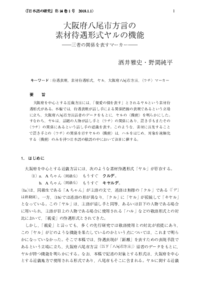大阪府八尾市方言の素材待遇形式ヤルの機能 ──三者の関係を表すマーカー──
ダウンロード数 : ? 件
この文献の参照には次のURLをご利用ください : https://ir.lib.shimane-u.ac.jp/49932
| ID | 49932 |
| ファイル | |
| 言語 |
日本語
|
| タイトルヨミ | オサカフ ヤオシ ホウゲン ノ ソザイ タイグウ ケイシキ ヤル ノ キノウ サンシャ ノ カンケイ ヲ アラワス マーカー
|
| 日本語以外のタイトル | Yaru in Yao Dialect, Osaka: A Marker to Indicate the Relationship of Three Persons
|
| 著者 |
酒井 雅史
大阪大学
|
| 内容記述(抄録等) | 大阪府を中心とする近畿方言には,「親愛の情を表す」とされるヤルという素材待遇形式がある。本稿では,待遇表現が話し手による関係把握の表現であるという立場に立ち,大阪府八尾市方言話者のデータをもとに,ヤルの〈機能〉を明らかにした。すなわち,ヤルは,話題の人物が話し手と〈ウチ〉の関係にあり,聞き手もまたその〈ウチ〉の関係にあるという話し手の認識を表す。このような,素材に言及することで聞き手との〈ウチ〉の関係を示すヤルの〈機能〉は,ハルをはじめ,対象を遠隔化する〈機能〉のみを持つ日本語の敬語の中において注目に値する。
|
| 内容記述(抄録等) | The aim of this article is to clarify the function of the subject honorifics form yaru in the Yao dialect of Osaka. In previous research, yaru is said to indicate the ‘endearment’ because it is used when the subject is younger than the speaker, or the same age. However, this article claims that the function of yaru is not to indicate the feeling of the speaker, but the relationship of the speaker, the hearer, and the subject from the viewpoint of the speaker. Yaru indicates the close relationship of the speaker, subject, and the hearer. Therefore it indicates that the three members are all in ‘internal’ (or close) relationship. This article claims that ‘endearment’, which is claimed as a main function of yaru in previous research, can be thought of as the discourse function by the use of the relation marker yaru.
Yaru is uncommon in that it represents the ‘close’ relationship of both the hearer and subject from the viewpoint of the speaker, while Japanese honorifics (linguistic politeness) are said to represent the ‘distant’ relationship to the subject or hearer from the viewpoint of the speaker. |
| 主題 | 待遇表現
素材待遇形式
ヤル
大阪府八尾市方言
〈ウチ〉マーカー
honorific expression
subject honorifics
yaru
Osaka Yao dialect
‘internal’ marker
|
| 掲載誌名 |
日本語の研究
|
| 巻 | 14
|
| 号 | 1
|
| 開始ページ | 1
|
| 終了ページ | 17
|
| ISSN | 1349-5119
|
| ISSN(Online) | 2189-5732
|
| 発行日 | 2018.1.1
|
| DOI | |
| 出版者 | 日本語学会
|
| 出版者ヨミ | ニホン ゴ ガッカイ
|
| 資料タイプ |
学術雑誌論文
|
| ファイル形式 |
PDF
|
| 著者版/出版社版 |
出版社版
|
| 業績ID | e33482
|
| 部局 |
法文学部
|
